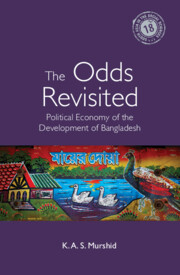Book contents
- Frontmatter
- Dedication
- Contents
- List of Tables and Figures
- Acknowledgements
- List of Abbreviations
- Introduction
- 1 A Bird’s-Eye View of the Bangladesh Economy: 1971–2020
- 2 Initial Conditions: The Odds Revisited
- 3 The Food Security Challenge
- 4 Exploring Transition and Change in the Rice Market
- 5 International Migration
- 6 The Rural Non-farm (RNF) Sector
- 7 Industrialization and the Rise of RMG
- 8 Industrialization: Other Stories
- 9 The Social Sector Puzzle
- 10 Dhaka: Capital Formation—Urbanization, Competition and the Rise of a Business Class
- Conclusion
- Notes
- Glossary
- References
- Index
8 - Industrialization: Other Stories
Published online by Cambridge University Press: 30 June 2022
- Frontmatter
- Dedication
- Contents
- List of Tables and Figures
- Acknowledgements
- List of Abbreviations
- Introduction
- 1 A Bird’s-Eye View of the Bangladesh Economy: 1971–2020
- 2 Initial Conditions: The Odds Revisited
- 3 The Food Security Challenge
- 4 Exploring Transition and Change in the Rice Market
- 5 International Migration
- 6 The Rural Non-farm (RNF) Sector
- 7 Industrialization and the Rise of RMG
- 8 Industrialization: Other Stories
- 9 The Social Sector Puzzle
- 10 Dhaka: Capital Formation—Urbanization, Competition and the Rise of a Business Class
- Conclusion
- Notes
- Glossary
- References
- Index
Summary
Introduction
The popular narrative of industrialization of Bangladesh is focused almost solely on RMG. While RMG is certainly the jewel in the industrial crown, there are many other smaller sectors that have sprouted up in the country, many responding to growing domestic demand emanating from a newly emerging middle class. Some of these non-RMG manufactures are also being exported, and while their shares to total exports are small, taken all together, they play a significant role in the economy in terms of employment and value addition. The real significance of all these numerous, small-scale activities, however, is not how much they account for in terms of shares of GDP but whether and what potential these hold for future growth and expansion. This is important because for over 20 years Bangladeshi policymakers have been searching for signs of an additional one or two sectors that could impart further impetus to export growth and diversification. The growing industrial strength reflected in a number of sectoral and sub-sectoral activities could well mark a turning point for Bangladesh's industrial fortunes. Most importantly, it demonstrates that the country has acquired considerable skills and capacities to undertake a large variety of manufacturing and processing activities, and under the right circumstances (that is, incentives and policy support, including protection), it could expand quickly. In other words, this is proof of capability. What is needed now is for Bangladesh to leverage this experience to chart out new areas of dynamic comparative advantage. A precondition for this to happen would be a change in the mindset of policymakers to look beyond RMG and consider other potential sectors for privileged policy incentives.
These ‘other sectors’ are a combination of mostly new manufacturing areas along with a few traditional ones that are attempting to resurface once again, using new technology and fresh branding approaches. Among the latter, jute and especially leather goods are often touted as having great potential. However, the promise of rehabilitating them has been elusive, although the leather sector has seen a degree of new investments and use of improved technology, including effluent treatment plants to reduce environmental pollution.
- Type
- Chapter
- Information
- The Odds RevisitedPolitical Economy of the Development of Bangladesh, pp. 114 - 142Publisher: Cambridge University PressPrint publication year: 2022



